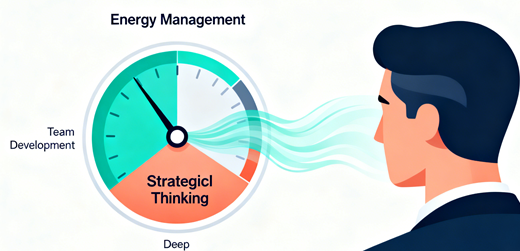The Executive Cognitive Leadership System
Lead with cognitive clarity and neurological intelligence. This system uses neuroscience principles to optimize decision-making, emotional regulation, and leadership presence through strategic cognitive mode switching.
The Executive Cognitive Leadership System: Lead with Neuroscience Intelligence
Modern leadership demands more than time management—it requires cognitive sophistication. This system applies organizational neuroscience to optimize your brain's leadership performance through strategic cognitive mode switching and neural pathway development.
The Cognitive Leadership Framework
Six Essential Leadership Cognitive Modes
1. Analytical Leadership (Prefrontal Cortex Dominant)
- Neural Basis: Central Executive Network
- Leadership Functions: Strategic planning, data analysis, logical decision-making
- Optimal Timing: Morning hours (8-11 AM)
- Activation Triggers: Quiet environment, clear objectives, data visualization
2. Relational Leadership (Social Brain Network)
- Neural Basis: Default Mode + Salience Networks
- Leadership Functions: Empathy, trust-building, team connection, emotional intelligence
- Optimal Timing: Late morning (10 AM-12 PM)
- Activation Triggers: Face-to-face interaction, active listening practice
3. Strategic Leadership (Prospective Cognition)
- Neural Basis: Hippocampal-prefrontal pathways
- Leadership Functions: Future planning, scenario thinking, opportunity recognition
- Optimal Timing: Early afternoon (2-4 PM)
- Activation Triggers: Visualization exercises, question framing
4. Adaptive Leadership (Integrative Cognition)
- Neural Basis: Whole-brain connectivity
- Leadership Functions: Complex problem-solving, systems thinking, innovation
- Optimal Timing: Mid-morning (9-11 AM)
- Activation Triggers: Cross-perspective analysis, pattern recognition
5. Presence Leadership (Attentional Control)
- Neural Basis: Anterior cingulate cortex
- Leadership Functions: Meeting leadership, active listening, emotional regulation
- Optimal Timing: Before important interactions
- Activation Triggers: Mindfulness practice, intention setting
6. Recovery Leadership (Neural Restoration)
- Neural Basis: Default mode network
- Leadership Functions: Insight generation, creativity, long-term memory consolidation
- Optimal Timing: Breaks, transitions, end of day
- Activation Triggers: Mind wandering, nature exposure, analog activities
The Neuroscience of Leadership Performance
Prefrontal Cortex Management
The PFC is your leadership command center but has limited resources:
Decision Fatigue Science:
- Quality declines after 3-4 hours of continuous decision-making
- Complex decisions should be scheduled before noon
- Simple, routine decisions are better for afternoon
Cognitive Load Optimization:
- Use external systems to reduce cognitive load
- Batch similar types of decisions
- Implement "decision-free" recovery periods
Emotional Contagion Mechanisms
Mirror Neuron System:
- Your emotional state directly influences your team
- Stress and anxiety are particularly contagious
- Intentional emotional signaling is a leadership responsibility
Amygdala Hijack Prevention:
- Recognize stress response triggers
- Implement pre-emptive recovery strategies
- Develop emotional regulation practices
Implementation Protocol
Daily Cognitive Rhythm Design
Morning (6:30-8:00 AM): Cognitive Preparation
- Meta-leadership visualization
- Strategic priority setting
- Prefrontal cortex activation exercises
Peak Performance (8:00-12:00 PM): High-Cognitive Demand
- Analytical and strategic leadership modes
- Complex decision-making
- Important creative work
Energy Transition (12:00-2:00 PM): Recovery and Integration
- Physical movement and nutrition
- Social connection without cognitive demand
- Mental rest and incubation
Afternoon (2:00-5:00 PM): Relational and Adaptive Leadership
- Team meetings and coaching
- Cross-functional collaboration
- Simpler decision batches
Evening (5:00-7:00 PM): Reflection and Recovery
- Daily learning capture
- Cognitive transition to personal time
- Neural recovery practices
Weekly Cognitive Cycle
Monday: Strategic Foundation
- Week planning and priority setting
- Analytical deep work sessions
- Leadership intention setting
Tuesday-Wednesday: Execution Focus
- Adaptive problem-solving
- Team leadership and development
- Project advancement
Thursday: Integration and Connection
- Cross-functional collaboration
- Strategic relationship building
- Systems thinking
Friday: Learning and Evolution
- Week review and learning capture
- Skill development and growth
- Next week planning
Advanced Cognitive Leadership Techniques
Cognitive Mode Switching
Transition Rituals:
- 5-minute breathing between different cognitive modes
- Physical movement to reset mental state
- Environment change to trigger new mindset
- Intention setting for next cognitive mode
Interruption Management:
- Protect high-cognitive demand blocks
- Schedule "office hours" for team access
- Use status indicators to communicate availability
- Batch administrative tasks
Neural Pathway Development
Deliberate Practice:
- Identify underutilized cognitive modes
- Schedule regular practice sessions
- Seek feedback on effectiveness
- Gradually increase complexity
Cognitive Diversity:
- Intentionally practice different thinking styles
- Seek perspectives that challenge your defaults
- Rotate through all six leadership modes weekly
- Develop cognitive flexibility metrics
Performance Measurement and Optimization
Cognitive Effectiveness Metrics
- Decision Quality: Track outcomes of key decisions
- Team Engagement: Measure impact of relational leadership
- Strategic Clarity: Assess forward-thinking effectiveness
- Personal Energy: Monitor cognitive fatigue patterns
Leadership Presence Assessment
- Meeting Effectiveness: Participant engagement and outcomes
- Listening Quality: Recall and response accuracy
- Emotional Influence: Team mood and energy correlation
- Adaptive Response: Handling unexpected challenges
Weekly Optimization Process
- Cognitive Audit: Review mode effectiveness and timing
- Pattern Analysis: Identify optimal cognitive rhythms
- Schedule Refinement: Adjust next week's cognitive allocation
- Skill Development: Target specific cognitive mode improvement
Troubleshooting Common Cognitive Leadership Challenges
When Overwhelmed by Complexity
- Return to foundational cognitive modes
- Break down problems into manageable components
- Schedule dedicated thinking time without pressure
- Use external thinking supports (whiteboards, diagrams)
When Team Energy is Low
- Increase relational leadership time
- Practice intentional positive emotional signaling
- Create clear wins and celebrations
- Monitor your own stress and recovery
When Stuck in Default Thinking
- deliberately switch cognitive modes
- Seek diverse perspectives intentionally
- Change physical environment and context
- Use provocative questions to break patterns
Stop managing your calendar and start optimizing your leadership brain. Click "Use This Template" to implement a neuroscience-backed system that transforms how you think, decide, and lead.
Open Schedule Maker to customize and export.

The Executive Energy Distributor
Lead with clarity and impact. This free executive schedule helps managers balance strategic thinking, team development, and deep work by aligning tasks with energy levels throughout the week. Based on energy leadership principles.
View details

The Digital Nomad Nervous System Optimizer
Optimize your nervous system for the digital nomad lifestyle. This neuroscience-based system addresses the unique cognitive challenges of location-independent work, from environmental adaptation to distributed presence management.
View details

The Knowledge Architecture Engineering System
Engineer robust knowledge architectures that withstand academic pressure. This system uses cognitive science principles to build interconnected knowledge frameworks, optimize neural pathways, and create durable academic understanding.
View details
